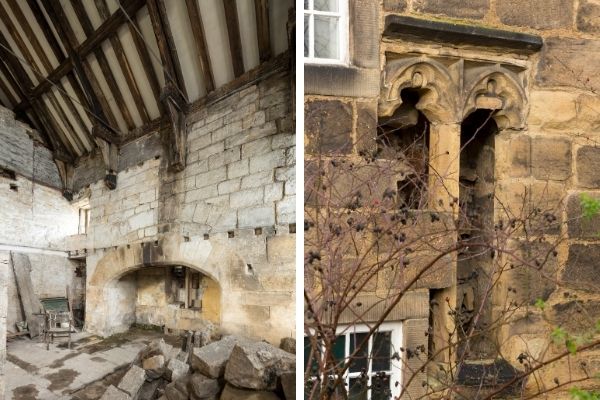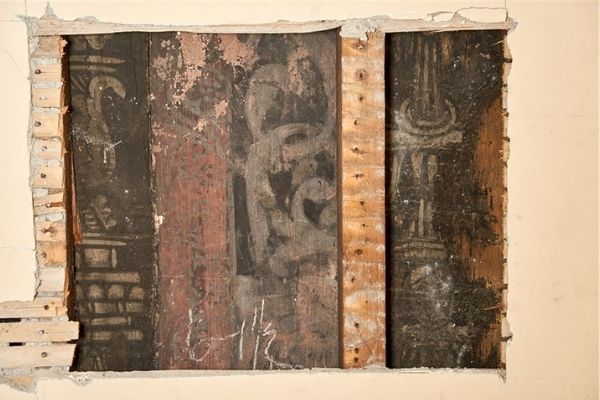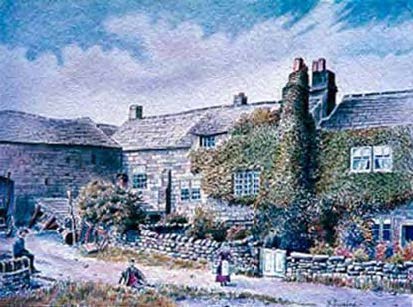Calverley Old Hall has a history of real fascination, and more will no doubt emerge as this project unfolds. Its story begins in the 12th century, when a family called Scot built a stone and timber house on the site, traces of which still survive.
Around 1300, they converted their original home into a grander stone dwelling. This had a large hall on the first floor (a hall being a communal space for the whole household) with service rooms below. This hall range had magnificent stone fireplaces on both floors, still there today. It is a rare survival of national significance.
The family soon took the name of the place as their own and for 500 years the Calverley family remained here, in a house that grew and changed over the centuries with their fortunes.
Many of the Calverley family’s papers and estate records survive in the British Library and beyond. Together, the papers and house tell a story of the family’s steady climb in wealth and status. The Calverleys added to their estates bit by bit and married into the leading families in the area. Many were knighted or served as magistrates and later as county sheriffs. Often, they were drawn into events of national importance, displaying military as well as administrative prowess.
A magnificent new great hall added in the 1480s
From a family tree that includes many generations of Calverley heirs named John, William and Walter, some stand out as individuals: Sir Walter, in the 1300s, was a vigorous improver, a pioneer of the iron industry, who sometimes clashed with the law. His son, also Walter, was more prudent, drawing up careful marriage settlements for his teenage children. In the 1480s, another William Calverley built an even larger great hall alongside the 14th-century house, which was now reserved for the family’s private use. The extraordinary new great hall survives today, complete with its mostly original hammer-beam roof and enormous stone fireplace. The tracery of medieval windows remains embedded in the walls. The family were devout, and also added the chapel with its oak-panelled ceiling, finely carved screen, and private first-floor gallery for the family entered from the solar.

Very rare Tudor wall paintings discovered in the parlour block
Recent dendrochronology has enabled us to date the roof of the small parlour block on the other side of the solar to the 1520s, and its floor to the mid-16th century. This spans the lifetimes of another Walter Calverley, who was knighted by Henry VIII and fought against the Scots, and of his son William. The 1530s brought Henry VIII’s religious reforms and the Calverleys were among many who found these hard to accept.
William was imprisoned in the Tower of London, where he wrote a pamphlet in verse retracting his disobedience and pledging full allegiance to Henry VIII and his religious reforms. William then became a pillar of the establishment. He was knighted in 1545 and served as Sheriff of Yorkshire in 1549 during the young Edward VI’s reign. He married twice and had seventeen children, so it is very likely he was responsible for adding the parlour block and a further lodging block alongside.
It is in the upper room of this parlour block that we have recently made the exciting discovery of extensive, and very rare, Tudor wall paintings, hidden behind early 20th-century lath and plaster. At a stroke, these paintings raise our perception of Calverley Old Hall from its currently crumbling state to its civilised existence at the height of the English Renaissance. It seems likely that it was Sir William who commissioned the wall paintings.

William’s son was another Walter. By now, the family had reverted to Catholicism and this made them suspect as citizens under the Protestant regime of Elizabeth I. They were subject to repeated fines for this recusancy. Religious fanaticism combined with ‘melancholick lunacie’ in Walter’s son and heir (another William). Their fortunes declined in the 1590s. When father and son both died in 1596, the next heir, Walter, was still a minor.
The ‘Yorkshire Tragedy’ in 1605
In April 1605, serious personal disaster struck the Calverley family. Overwhelmed by debt and doubting his wife’s faithfulness, this Walter Calverley murdered his two small sons. Unrepentant but refusing to enter a plea, Walter was executed in York by being literally pressed to death under heavy stones. The murders were dramatized as A Yorkshire Tragedy, performed by the King’s Men at The Globe and originally attributed to William Shakespeare, but now considered the work of Thomas Middleton. The baby son who survived the tragedy, Henry, is a poignant figure, dogged by ill luck in youth and later burdened by a huge fine imposed by Parliament for being a Royalist.
Blog: New Thoughts on A Yorkshire Tragedy
The Calverley’s move to Esholt Hall
The family’s fortunes revived in the next generation. Its Walter married Frances Thompson of Esholt, which resulted in the main family seat moving from Calverley to Esholt Hall, which was rebuilt. The Old Hall began to be subdivided as weavers’ cottages. In 1706, their son Walter (created 1st Baronet in 1711) married a wealthy heiress, Julia Blackett of Wallington Hall in Northumberland. A busy, contented and prosperous man, Sir Walter is a possible source for Sir Roger de Coverley, Addison's archetypal country squire of The Spectator. Sir Walter was the last of his family to have much to do with Calverley. His son, Sir Walter Calverley Blackett, was a career politician representing Newcastle-upon-Tyne in Westminster, who took the Blackett family name in order to inherit his uncle's substantial estates at Wallington Hall, which he made his main residence.
Sale in 1754 and subsequent division into cottages
In 1754, the ancient link between Calverley and the Calverleys came to an end when Sir Walter Calverley Blackett sold the Calverley estate to Thomas Thornhill of Fixby. The Old Hall was further divided into cottages, and by 1861 there were 11 separate households living on the site. Even the chapel was converted as a dwelling.

A late 19th-century watercolour by local artist Fred Swaine shows the Old Hall divided into cloth workers’ cottages.
In 1977, the 17th-century lodging block was gutted by fire and, with all the cottages on the site becoming dilapidated, the Thornhill Estate put Calverley Old Hall up for sale in three different lots. In 1981, the Landmark Trust stepped in to keep this magnificent medieval manor house in single ownership and to begin the long journey of restoring and reviving the whole site. The repaired former lodging block opened as a Landmark in 1982, while the life tenancies of the sitting tenants were allowed to play out.

Now we at last we are able to plan an exciting new future for the whole site, realising its potential to inspire both Landmarkers and the local community in which this marvellous site sits.
Watch buildings archaeologist Dr Jonathan Clark take a tour of Calverley Old Hall
Explore Calverley with our virtual tour
Calverley virtual tour